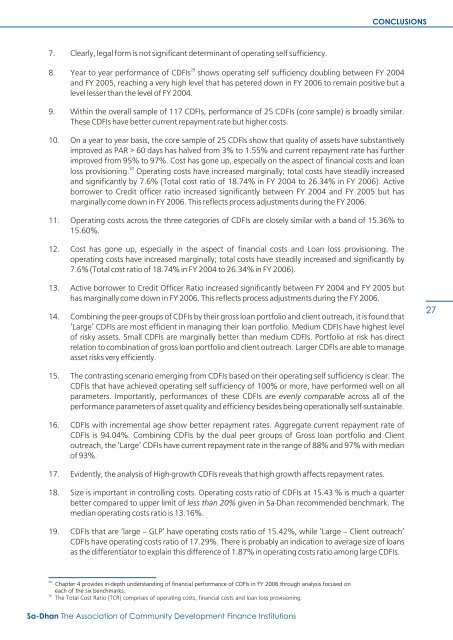Read - Sa-Dhan
Read - Sa-Dhan
Read - Sa-Dhan
You also want an ePaper? Increase the reach of your titles
YUMPU automatically turns print PDFs into web optimized ePapers that Google loves.
CONCLUSIONS<br />
7. Clearly, legal form is not significant determinant of operating self sufficiency.<br />
29<br />
8. Year to year performance of CDFIs shows operating self sufficiency doubling between FY 2004<br />
and FY 2005, reaching a very high level that has petered down in FY 2006 to remain positive but a<br />
level lesser than the level of FY 2004.<br />
9. Within the overall sample of 117 CDFIs, performance of 25 CDFIs (core sample) is broadly similar.<br />
These CDFIs have better current repayment rate but higher costs.<br />
10. On a year to year basis, the core sample of 25 CDFIs show that quality of assets have substantively<br />
improved as PAR > 60 days has halved from 3% to 1.55% and current repayment rate has further<br />
improved from 95% to 97%. Cost has gone up, especially on the aspect of financial costs and loan<br />
30<br />
loss provisioning. Operating costs have increased marginally; total costs have steadily increased<br />
and significantly by 7.6% (Total cost ratio of 18.74% in FY 2004 to 26.34% in FY 2006). Active<br />
borrower to Credit officer ratio increased significantly between FY 2004 and FY 2005 but has<br />
marginally come down in FY 2006. This reflects process adjustments during the FY 2006.<br />
11. Operating costs across the three categories of CDFIs are closely similar with a band of 15.36% to<br />
15.60%.<br />
12. Cost has gone up, especially in the aspect of financial costs and Loan loss provisioning. The<br />
operating costs have increased marginally; total costs have steadily increased and significantly by<br />
7.6% (Total cost ratio of 18.74% in FY 2004 to 26.34% in FY 2006).<br />
13. Active borrower to Credit Officer Ratio increased significantly between FY 2004 and FY 2005 but<br />
has marginally come down in FY 2006. This reflects process adjustments during the FY 2006.<br />
14. Combining the peer-groups of CDFIs by their gross loan portfolio and client outreach, it is found that<br />
‘Large’ CDFIs are most efficient in managing their loan portfolio. Medium CDFIs have highest level<br />
of risky assets. Small CDFIs are marginally better than medium CDFIs. Portfolio at risk has direct<br />
relation to combination of gross loan portfolio and client outreach. Larger CDFIs are able to manage<br />
asset risks very efficiently.<br />
27<br />
15. The contrasting scenario emerging from CDFIs based on their operating self sufficiency is clear. The<br />
CDFIs that have achieved operating self sufficiency of 100% or more, have performed well on all<br />
parameters. Importantly, performances of these CDFIs are evenly comparable across all of the<br />
performance parameters of asset quality and efficiency besides being operationally self-sustainable.<br />
16. CDFIs with incremental age show better repayment rates. Aggregate current repayment rate of<br />
CDFIs is 94.04%. Combining CDFIs by the dual peer groups of Gross loan portfolio and Client<br />
outreach, the ‘Large’ CDFIs have current repayment rate in the range of 88% and 97% with median<br />
of 93%.<br />
17. Evidently, the analysis of High-growth CDFIs reveals that high growth affects repayment rates.<br />
18. Size is important in controlling costs. Operating costs ratio of CDFIs at 15.43 % is much a quarter<br />
better compared to upper limit of less than 20% given in <strong>Sa</strong>-<strong>Dhan</strong> recommended benchmark. The<br />
median operating costs ratio is 13.16%.<br />
19. CDFIs that are ‘large – GLP’ have operating costs ratio of 15.42%, while ‘Large – Client outreach’<br />
CDFIs have operating costs ratio of 17.29%. There is probably an indication to average size of loans<br />
as the differentiator to explain this difference of 1.87% in operating costs ratio among large CDFIs.<br />
29<br />
30<br />
Chapter 4 provides in-depth understanding of financial performance of CDFIs in FY 2006 through analysis focused on<br />
each of the six benchmarks.<br />
The Total Cost Ratio (TCR) comprises of operating costs, financial costs and loan loss provisioning.<br />
<strong>Sa</strong>-<strong>Dhan</strong> The Association of Community Development Finance Institutions
















